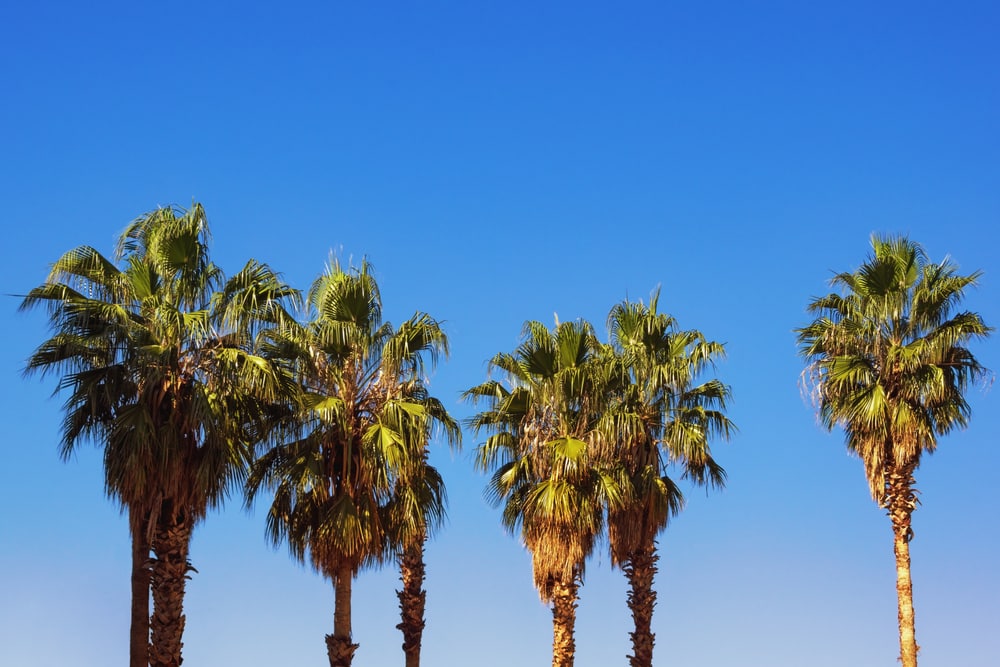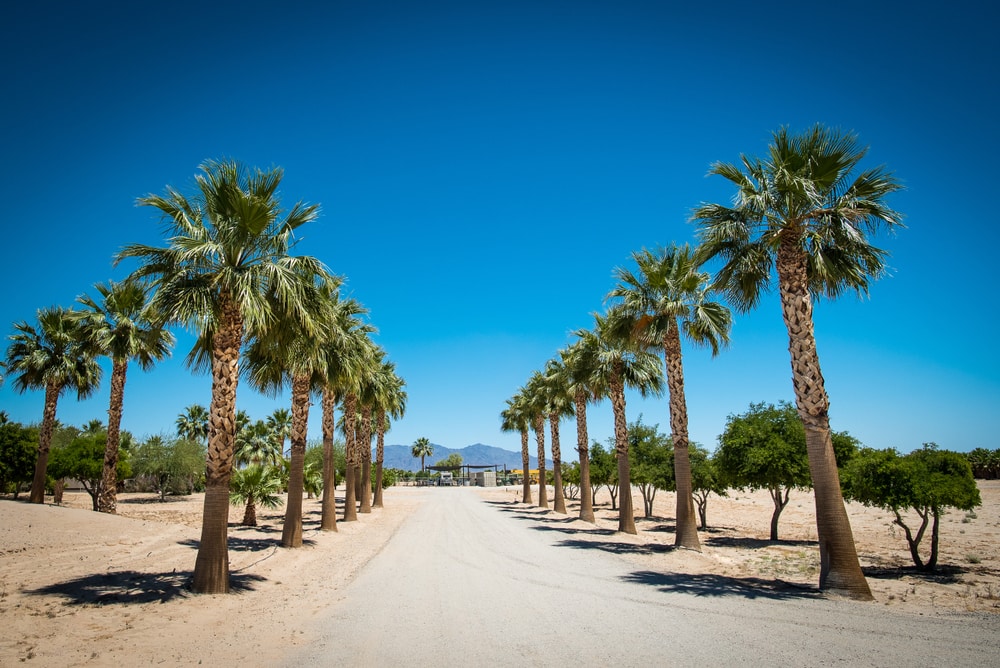With its classic look, the Washingtonia Palm is an iconic tree that will add a touch of the tropics to your garden. It’s a quick-growing palm that grows up to 3 feet in just one year, so it will need lots of space to really thrive. It can reach its full height of up to 1200 inches or a stunning 100 feet and it might be too tall for a residential area.
It is native to Mexico but surprisingly grows well in the state of Florida. This palm is known to be carefree and is perfect for any gardener, whether you’re a beginner or an experienced pro.
| Botanical Name | Washingtonia robusta |
| Common Name | Washingtonia Palm, Mexican Fan Palm, Mexican Washingtonia |
| Plant Type | Perennial |
| Flower Color | White, small, and slightly fragrant |
| Size When Mature | 840-1200 Inches |
| Bloom Time | Spring |
| Sun Requirements | Full Sun to Partial Shade |
| USDA Hardiness Zones | 9-11 |
| Soil PH Range | 7.0 and below |
| Soil Type | Loam, well-draining |
| Water Needs | Low |
| Native Area | Mexico |
What You Need to Know About Washingtonia Palm
The Washingtonia Palm boasts of its leaves that are in the shape of a fan and measure roughly 3 to 5 feet wide. They have sharp-toothed petioles that are approximately 4 to 6 feet. Its dead leaves will likely cover the trunk if untrimmed, forming a brown and shaggy covering that very much resembles a hula skirt.
It blooms creamy white flowers in spring and they are very tiny with a very subtle smell. These flowers grow in clusters that extend longer than their leaves. It will soon produce black fruits that taste like dates. Fortunately, this palm is relatively safe for humans and pets. It is easy to grow as long as you provide it with the right conditions.
How to Care for Washingtonia Palm
Here’s everything you need to know about growing and caring for a thriving Washingtonia Palm:
Light
These palms are native to the desert and naturally love the sun. They flourish in full sun to partial shade. It will grow best with at least four hours of direct sunlight every day.
Water and Soil Needs
This palm is very drought-tolerant and it will need very little water once it’s established, so it’s perfect for those who don’t want to spend a lot of time watering their plants. You can water once every five to ten days during the summer, seven to ten days during spring and fall, and two to three weeks in the winter respectively. It grows well on loam, well-draining soil with a pH of 7.0 and below that’s neutral to acidic.
Temperature Requirements
The good thing about Washingtonia Palms is that they are relatively hardy even down to 20°F. It can survive in USDA zones 9 to 11.
Fertilizer
The best fertilizer to use on a Washingtonia Palm is a good palm tree fertilizer with micronutrients. It is important to keep your plant fed to help it survive during the cold and freezing weather. In order to prevent nutrient deficiency, it is ideal to fertilize biannually during its growing season. This will also encourage growth and maintain its good health.
Common Diseases
Washingtonia Palm is susceptible to all common diseases for other species of palms. However, potassium deficiency is a common issue for this type of palm. If your plant has this problem, it can show symptoms like leaf tip necrosis where the tips of the leaves turn brown and die.
There could also be leaf discoloration and stunted growth. The good news is that this can be fixed by simply applying a potassium sulfate fertilizer to your plant. You can also use compost and manure to amend the soil and help the plant absorb more nutrients.
There could be a few pests that might infest your Washingtonia Palm and these may include spider mites and scale. Spider mites are tiny pests that suck the sap from the leaves, causing them to turn yellow and eventually brown. They also leave behind webbing that can be unsightly.
Scale, on the other hand, are small insects that attach themselves to the plant and feed on its sap. If you see any of these pests on your plant, it is important to take action immediately before they can cause significant damage. You can get rid of these insects by using an insecticide or horticultural oil.
Ganoderma root and butt rot is lethal to all species of palms, the Washingtonia Palm included. This disease is caused by a fungal infection wherein the first symptom of this disease is yellowing leaves followed by browning and wilting.
The leaves will eventually die and fall off the plant. The Ganoderma fungus will then infect the trunk, causing it to collapse. There is no known cure for this disease and once your plant is infected, the best thing you can do is to remove it and destroy it to prevent the spread of the infection.
Washingtonia Palm Propagation
Washingtonia Palm is easily grown from seeds. The seeds generally germinate in just a span of two weeks when kept in warm and moist conditions.
Related article: Why do Palm Leaves Turn Yellow?


